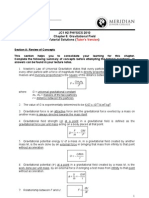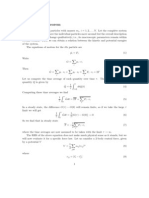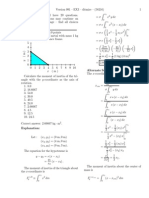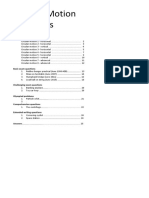AP Physics 1 - Simple Harmonic Motion Review
AP Physics 1 - Simple Harmonic Motion Review
Uploaded by
loncharnettCRCopyright:
Available Formats
AP Physics 1 - Simple Harmonic Motion Review
AP Physics 1 - Simple Harmonic Motion Review
Uploaded by
loncharnettCRCopyright
Available Formats
Share this document
Did you find this document useful?
Is this content inappropriate?
Copyright:
Available Formats
AP Physics 1 - Simple Harmonic Motion Review
AP Physics 1 - Simple Harmonic Motion Review
Uploaded by
loncharnettCRCopyright:
Available Formats
Simple Harmonic Motion Review Sheet
Definitions:
Simple Harmonic Motion - Motion that is repeated back and forth
Period - Time to complete one cycle (measured in seconds, symbol is T)
Frequency - Number of cycles completed in one second (measured in Hz, symbol is Hz)
Amplitude - Magnitude of max displacement from point of equilibrium (symbol is A)
Wavelength - Distance between successive points on a wave
Restoring force - The force that acts against the current motion of the object and points towards
equilibrium position
Small Angle Approximation - For small angles, sin θ = θ, which we can use to find the period
of a pendulum undergoing simple harmonic motion
Damping - When the motion of an oscillating object is reduced by an external force. Total
mechanical energy is no longer constant (decreasing)
Equations:
Hooke’s law: F = k*x
Period of a spring: T = 2π * sqrt(m/k)
Position: A*cos(2π*f*t)
Velocity: -(2π*f) * A*sin(2π*f*t)
Acceleration: -(2π*f)^2 * A * cos(2π*f*t)
Total mechanical energy of a spring: (½)mv^2 + (½)kx^2 = K + U = E, E = ½*k*A^2
Period of a pendulum: T = 2π * sqrt(l/g)
Example Problem: The period of oscillation of a vertically hanging spring is 3 seconds. What
will it be if the mass is doubled? What about if gravity is doubled?
Answer: Equation for period of a spring is T = 2π * sqrt(m/k), so period will increase by a factor
of sqrt(2) if mass is doubled, making it about 4.2 seconds. Gravity doesn’t affect period, so it will
stay at 3 seconds.
You might also like
- Chapter 3 Motion in 2DDocument7 pagesChapter 3 Motion in 2Dbmz00000No ratings yet
- 183 - PR 23 - Foucault Pendulum AnalysisDocument2 pages183 - PR 23 - Foucault Pendulum AnalysisBradley NartowtNo ratings yet
- Take Home WorksheetDocument3 pagesTake Home WorksheetXu ShennaNo ratings yet
- 37 Modern-Mass Energy EquivalenceDocument2 pages37 Modern-Mass Energy EquivalenceeltytanNo ratings yet
- U1 - Lissajous FiguresDocument18 pagesU1 - Lissajous Figuresdhullyash228100% (1)
- 2015 PhySc GRD 12 Photoelectric Effect NotesDocument48 pages2015 PhySc GRD 12 Photoelectric Effect Notesdatboydion1No ratings yet
- Gravitation Tutorial and Sol Q1 To 8 OnlyDocument11 pagesGravitation Tutorial and Sol Q1 To 8 OnlyJarrell YappNo ratings yet
- SPH4U Sample Test - Kinematics+KeyDocument3 pagesSPH4U Sample Test - Kinematics+KeyssshhawnNo ratings yet
- Simple Harmonic MotionDocument21 pagesSimple Harmonic MotionHabimana HassanNo ratings yet
- 068 - Physics hw-6Document8 pages068 - Physics hw-6Jesse LuNo ratings yet
- Chapter 6: Wave: 6.1 Understanding WavesDocument35 pagesChapter 6: Wave: 6.1 Understanding WavesZulhisyam NordinNo ratings yet
- Mass and Inertia: Dynamics 1Document11 pagesMass and Inertia: Dynamics 1Joe West100% (2)
- NikkuDocument36 pagesNikkuNishkarsh AroraNo ratings yet
- Calculus (Test 1 Question)Document5 pagesCalculus (Test 1 Question)Bala GanabathyNo ratings yet
- Simple Harmonic Motion Multiple Choice-2013!07!11Document5 pagesSimple Harmonic Motion Multiple Choice-2013!07!11Vishal NanwaniNo ratings yet
- CH 03 HWDocument36 pagesCH 03 HWClayton KwokNo ratings yet
- Collisions: Previous Eamcet Questions EngineeringDocument12 pagesCollisions: Previous Eamcet Questions Engineeringeamcetmaterials100% (1)
- Conservation of Momentum MCQ TestDocument7 pagesConservation of Momentum MCQ Testmann123No ratings yet
- Circular Motion Problems Answers PDFDocument5 pagesCircular Motion Problems Answers PDFSinthuNathanNo ratings yet
- Center of Mass and Linear MomentumDocument20 pagesCenter of Mass and Linear Momentumsojib yeasin100% (1)
- Motion in A Plane PDFDocument18 pagesMotion in A Plane PDFRohitNo ratings yet
- ForcesDocument51 pagesForcesRuthwik H ParamNo ratings yet
- Physics Test Review ForcesDocument2 pagesPhysics Test Review ForceslinlinycNo ratings yet
- AP C Mech 1. Unit 1. Kinematics One Dimensional Motion Part 2Document11 pagesAP C Mech 1. Unit 1. Kinematics One Dimensional Motion Part 2moonidiveNo ratings yet
- Energy Momentum Practice TestDocument11 pagesEnergy Momentum Practice TestMohamad SotoudehNo ratings yet
- Inequality Sat Practise For MathDocument11 pagesInequality Sat Practise For MathYogesh AgrawalNo ratings yet
- 03 Physics 11se Ua EndDocument6 pages03 Physics 11se Ua Endpecan_lisa38No ratings yet
- Virial Theorem ProofDocument2 pagesVirial Theorem Proofjohnsmith37758No ratings yet
- Chapter 8 PPT - Maxwell.importantDocument15 pagesChapter 8 PPT - Maxwell.importantOsama Hassan100% (1)
- Walker4 Ism Ch23Document32 pagesWalker4 Ism Ch23mariomato100% (1)
- EX3 SolutionsDocument14 pagesEX3 SolutionsChase JuhlNo ratings yet
- Eee Formula Sheet PDFDocument143 pagesEee Formula Sheet PDFKiran Patil0% (1)
- Work, Power and Energy-1Document49 pagesWork, Power and Energy-1manyaelhanceNo ratings yet
- Elastic and Inelastic CollisionDocument9 pagesElastic and Inelastic CollisionSantosh RathoreNo ratings yet
- CommutatorDocument6 pagesCommutatormarsNo ratings yet
- 186 Momentum CollisionsDocument5 pages186 Momentum CollisionsDimKam1100% (1)
- Nota Physics Vol 3 Chap 5 (Circular Motion)Document70 pagesNota Physics Vol 3 Chap 5 (Circular Motion)Ernest YapNo ratings yet
- Acceleration: Acceleration, in Physics, Is The Rate ofDocument31 pagesAcceleration: Acceleration, in Physics, Is The Rate ofstallone21No ratings yet
- Photoelectric Effect Problems AnswersDocument1 pagePhotoelectric Effect Problems AnswersLuisa Gardênia Farias100% (2)
- Basics Prepared by Sombir Ahlawat Sir: Worksheet - 2 - Distance FormulaDocument6 pagesBasics Prepared by Sombir Ahlawat Sir: Worksheet - 2 - Distance FormulaSombir AhlawatNo ratings yet
- Class11 - Physics - Motion in A Plane - SolutionsDocument14 pagesClass11 - Physics - Motion in A Plane - Solutionsajmerkaur947No ratings yet
- Chapter 2 Notes - Motion Along A Straight LineDocument2 pagesChapter 2 Notes - Motion Along A Straight LinedoodoostixNo ratings yet
- Circular Motion Questions?Document29 pagesCircular Motion Questions?Muhammad RafayNo ratings yet
- Ch04 Homework SolutionsDocument88 pagesCh04 Homework SolutionsOsama Maher100% (1)
- XI Physcis MCQSDocument10 pagesXI Physcis MCQSerum shomailNo ratings yet
- Conservation of EnergyDocument2 pagesConservation of EnergyShaine InoveroNo ratings yet
- (25382) 17. H Projectile Motion QuestionsDocument8 pages(25382) 17. H Projectile Motion QuestionsDEEPJYOTI DEKANo ratings yet
- Duffing EquationDocument7 pagesDuffing EquationParsa SadeghiNo ratings yet
- Elastic Collision With C++Document12 pagesElastic Collision With C++qud86No ratings yet
- Dual NatureDocument6 pagesDual NaturejagatdhatriNo ratings yet
- ZCA101 FormulaeDocument15 pagesZCA101 Formulaesha_beeNo ratings yet
- Mcv4u Unit 1Document36 pagesMcv4u Unit 1Zaidi LindaNo ratings yet
- Unit 1 - Physics - WWW - Rgpvnotes.inDocument15 pagesUnit 1 - Physics - WWW - Rgpvnotes.inMayank SharmaNo ratings yet
- Motion in A Straight LineDocument67 pagesMotion in A Straight LineMichael CarnovaleNo ratings yet
- Newton's Law Note Physics IB HLDocument4 pagesNewton's Law Note Physics IB HLsupergirl123No ratings yet
- SPH4U Relativity AssignmentDocument2 pagesSPH4U Relativity AssignmentMatthew GreesonNo ratings yet
- Oscillations PDFDocument22 pagesOscillations PDFSanatan KumarNo ratings yet
- A2 H 41c Shm&oscillationsDocument38 pagesA2 H 41c Shm&oscillationsHany ElGezawyNo ratings yet
- Microsoft PowerPoint - Lecture Notes 1 - 213 (Oscillations)Document21 pagesMicrosoft PowerPoint - Lecture Notes 1 - 213 (Oscillations)Joshua DuffyNo ratings yet



























































